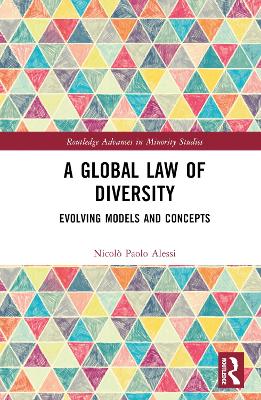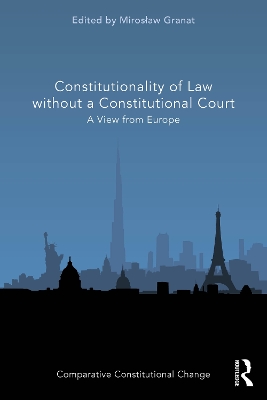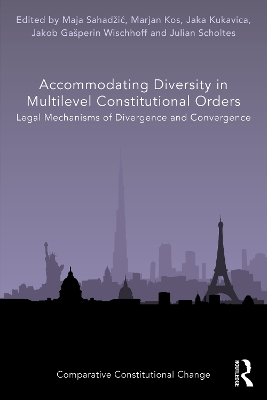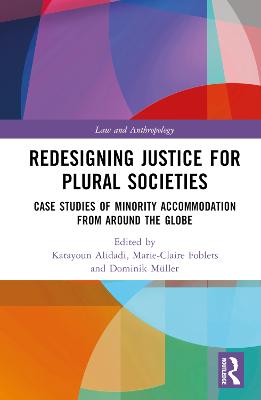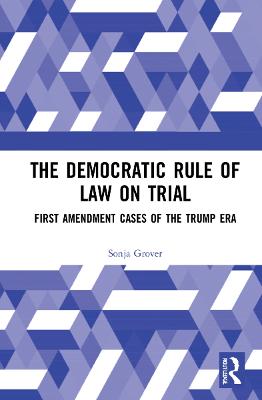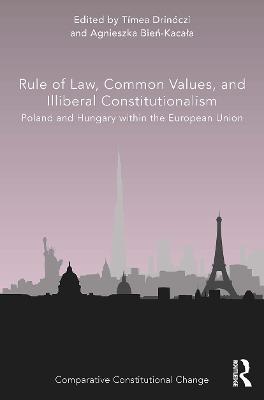Fundamental Labour Rights and the Constitution
 portes grátis
portes grátis
Fundamental Labour Rights and the Constitution
Constitutional Balancing in Italy and Spain
Frosecchi, Giulia
Taylor & Francis Ltd
12/2024
200
Mole
9780367725716
Pré-lançamento - envio 15 a 20 dias após a sua edição
Descrição não disponível.
List of abbreviations
Introduction: From the EU crisis to constitutional balancing
1 Constitutional balancing of fundamental labour rights
1.1 Introduction
1.2 Constitutional balancing as a method and its theoretical justifications
1.2.1 Against constitutional balancing
1.2.2 The balancing actors
1.2.3 The axiological nature of fundamental labour rights
1.3 Balancing technique(s)
1.3.1 The proportionality test, a critique
1.4 Balancing in fundamental social rights' adjudication and the essential content dilemma
1.4.1 Italian and Spanish insights on the notion of essential content
1.5 Conclusions
2 Constitutional balancing techniques in the world: A glimpse
2.1 Introduction
2.2 A worldwide panoramic of constitutional balancing
2.3 Balancing in supranational courts
2.3.1 The CJEU way of balancing: a labour reading
2.3.2 The ECtHR way of balancing: a labour reading
2.3.3 On reasonableness
2.3.4 Around values, balancing and proportionality in supranational courts
2.4 A reappraisal of constitutional balancing in Italy and Spain
2.4.1 Balancing in the Italian constitutional case law
2.4.2 Applied balancing in the Spanish constitutional case law and the principle of proportionality
2.4.3 Financial and economic factors in the Constitutional Courts' case law
2.5 Conclusions
3 Italian and Spanish post-crisis case law and "its" fundamental labour rights
3.1 Introduction
3.2 The relevant Italian post-crisis case law
3.2.1 Public employees' wage reduction before the Court
3.2.2 Retirement benefits revaluation and the modulation of the Court
3.2.3 On compensation for unjustified dismissal
3.3 The relevant Spanish post-crisis case law
3.3.1 The first and comprehensive judgment on the 2012 labour reform
3.3.2 The second and consistent judgment, one year later
3.4 Fundamental labour rights in the balance
3.4.1 The right to work
3.4.2 The right to collective bargaining
3.4.3 The right to a sufficient and proportionate remuneration and the principle of adequacy of pensions in the Italian case law
3.5 Conclusions
4 Constitutional balancing in the Italian and Spanish post-crisis case law
4.1 Introduction
4.2 The role of the Courts
4.3 The technique applied to supervise the legislator's balancing
4.3.1 The principle of reasonableness that permeates the Italian constitutional post-crisis case law
4.3.2 The stone guest of the Spanish constitutional post-crisis case law: the principle of proportionality
4.4 The terms balanced
4.4.1 The Italian post-crisis case law and the public financial contingencies
4.4.2 The Spanish post-crisis case law and the overriding fight against unemployment
4.4.3 The economic crisis argument, in the balance?
4.4.4 An uncontroversial axiological term: the freedom to conduct a business
4.5 Conclusions
Conclusions
Bibliography
Index
Introduction: From the EU crisis to constitutional balancing
1 Constitutional balancing of fundamental labour rights
1.1 Introduction
1.2 Constitutional balancing as a method and its theoretical justifications
1.2.1 Against constitutional balancing
1.2.2 The balancing actors
1.2.3 The axiological nature of fundamental labour rights
1.3 Balancing technique(s)
1.3.1 The proportionality test, a critique
1.4 Balancing in fundamental social rights' adjudication and the essential content dilemma
1.4.1 Italian and Spanish insights on the notion of essential content
1.5 Conclusions
2 Constitutional balancing techniques in the world: A glimpse
2.1 Introduction
2.2 A worldwide panoramic of constitutional balancing
2.3 Balancing in supranational courts
2.3.1 The CJEU way of balancing: a labour reading
2.3.2 The ECtHR way of balancing: a labour reading
2.3.3 On reasonableness
2.3.4 Around values, balancing and proportionality in supranational courts
2.4 A reappraisal of constitutional balancing in Italy and Spain
2.4.1 Balancing in the Italian constitutional case law
2.4.2 Applied balancing in the Spanish constitutional case law and the principle of proportionality
2.4.3 Financial and economic factors in the Constitutional Courts' case law
2.5 Conclusions
3 Italian and Spanish post-crisis case law and "its" fundamental labour rights
3.1 Introduction
3.2 The relevant Italian post-crisis case law
3.2.1 Public employees' wage reduction before the Court
3.2.2 Retirement benefits revaluation and the modulation of the Court
3.2.3 On compensation for unjustified dismissal
3.3 The relevant Spanish post-crisis case law
3.3.1 The first and comprehensive judgment on the 2012 labour reform
3.3.2 The second and consistent judgment, one year later
3.4 Fundamental labour rights in the balance
3.4.1 The right to work
3.4.2 The right to collective bargaining
3.4.3 The right to a sufficient and proportionate remuneration and the principle of adequacy of pensions in the Italian case law
3.5 Conclusions
4 Constitutional balancing in the Italian and Spanish post-crisis case law
4.1 Introduction
4.2 The role of the Courts
4.3 The technique applied to supervise the legislator's balancing
4.3.1 The principle of reasonableness that permeates the Italian constitutional post-crisis case law
4.3.2 The stone guest of the Spanish constitutional post-crisis case law: the principle of proportionality
4.4 The terms balanced
4.4.1 The Italian post-crisis case law and the public financial contingencies
4.4.2 The Spanish post-crisis case law and the overriding fight against unemployment
4.4.3 The economic crisis argument, in the balance?
4.4.4 An uncontroversial axiological term: the freedom to conduct a business
4.5 Conclusions
Conclusions
Bibliography
Index
Este título pertence ao(s) assunto(s) indicados(s). Para ver outros títulos clique no assunto desejado.
Fundamental labour rights;Constitutional balancing;Neo-constitutionalism;Economic crisis;Public budget constraints;Constitutional Courts;Supranational Courts;Supreme Courts;Balancing techniques;Principle of proportionality;Principle of reasonableness;Proportionality Test;Public Administration;EU Institution;Judicial Balancing;Spanish Constitutional Courts;Proportionality Principle;EU Legal Order;Fundamental Social Rights;Retirement Benefits;EU's Open Method;Constitutional Case Law;Fiscal Compact;EU Law;Essential Content;Trade Union Freedom;Axiological Nature;EU Context;Company Level Collective Agreement;ECB;EU Legal Framework;Collective Bargaining;EU Legislator;EU Member States
List of abbreviations
Introduction: From the EU crisis to constitutional balancing
1 Constitutional balancing of fundamental labour rights
1.1 Introduction
1.2 Constitutional balancing as a method and its theoretical justifications
1.2.1 Against constitutional balancing
1.2.2 The balancing actors
1.2.3 The axiological nature of fundamental labour rights
1.3 Balancing technique(s)
1.3.1 The proportionality test, a critique
1.4 Balancing in fundamental social rights' adjudication and the essential content dilemma
1.4.1 Italian and Spanish insights on the notion of essential content
1.5 Conclusions
2 Constitutional balancing techniques in the world: A glimpse
2.1 Introduction
2.2 A worldwide panoramic of constitutional balancing
2.3 Balancing in supranational courts
2.3.1 The CJEU way of balancing: a labour reading
2.3.2 The ECtHR way of balancing: a labour reading
2.3.3 On reasonableness
2.3.4 Around values, balancing and proportionality in supranational courts
2.4 A reappraisal of constitutional balancing in Italy and Spain
2.4.1 Balancing in the Italian constitutional case law
2.4.2 Applied balancing in the Spanish constitutional case law and the principle of proportionality
2.4.3 Financial and economic factors in the Constitutional Courts' case law
2.5 Conclusions
3 Italian and Spanish post-crisis case law and "its" fundamental labour rights
3.1 Introduction
3.2 The relevant Italian post-crisis case law
3.2.1 Public employees' wage reduction before the Court
3.2.2 Retirement benefits revaluation and the modulation of the Court
3.2.3 On compensation for unjustified dismissal
3.3 The relevant Spanish post-crisis case law
3.3.1 The first and comprehensive judgment on the 2012 labour reform
3.3.2 The second and consistent judgment, one year later
3.4 Fundamental labour rights in the balance
3.4.1 The right to work
3.4.2 The right to collective bargaining
3.4.3 The right to a sufficient and proportionate remuneration and the principle of adequacy of pensions in the Italian case law
3.5 Conclusions
4 Constitutional balancing in the Italian and Spanish post-crisis case law
4.1 Introduction
4.2 The role of the Courts
4.3 The technique applied to supervise the legislator's balancing
4.3.1 The principle of reasonableness that permeates the Italian constitutional post-crisis case law
4.3.2 The stone guest of the Spanish constitutional post-crisis case law: the principle of proportionality
4.4 The terms balanced
4.4.1 The Italian post-crisis case law and the public financial contingencies
4.4.2 The Spanish post-crisis case law and the overriding fight against unemployment
4.4.3 The economic crisis argument, in the balance?
4.4.4 An uncontroversial axiological term: the freedom to conduct a business
4.5 Conclusions
Conclusions
Bibliography
Index
Introduction: From the EU crisis to constitutional balancing
1 Constitutional balancing of fundamental labour rights
1.1 Introduction
1.2 Constitutional balancing as a method and its theoretical justifications
1.2.1 Against constitutional balancing
1.2.2 The balancing actors
1.2.3 The axiological nature of fundamental labour rights
1.3 Balancing technique(s)
1.3.1 The proportionality test, a critique
1.4 Balancing in fundamental social rights' adjudication and the essential content dilemma
1.4.1 Italian and Spanish insights on the notion of essential content
1.5 Conclusions
2 Constitutional balancing techniques in the world: A glimpse
2.1 Introduction
2.2 A worldwide panoramic of constitutional balancing
2.3 Balancing in supranational courts
2.3.1 The CJEU way of balancing: a labour reading
2.3.2 The ECtHR way of balancing: a labour reading
2.3.3 On reasonableness
2.3.4 Around values, balancing and proportionality in supranational courts
2.4 A reappraisal of constitutional balancing in Italy and Spain
2.4.1 Balancing in the Italian constitutional case law
2.4.2 Applied balancing in the Spanish constitutional case law and the principle of proportionality
2.4.3 Financial and economic factors in the Constitutional Courts' case law
2.5 Conclusions
3 Italian and Spanish post-crisis case law and "its" fundamental labour rights
3.1 Introduction
3.2 The relevant Italian post-crisis case law
3.2.1 Public employees' wage reduction before the Court
3.2.2 Retirement benefits revaluation and the modulation of the Court
3.2.3 On compensation for unjustified dismissal
3.3 The relevant Spanish post-crisis case law
3.3.1 The first and comprehensive judgment on the 2012 labour reform
3.3.2 The second and consistent judgment, one year later
3.4 Fundamental labour rights in the balance
3.4.1 The right to work
3.4.2 The right to collective bargaining
3.4.3 The right to a sufficient and proportionate remuneration and the principle of adequacy of pensions in the Italian case law
3.5 Conclusions
4 Constitutional balancing in the Italian and Spanish post-crisis case law
4.1 Introduction
4.2 The role of the Courts
4.3 The technique applied to supervise the legislator's balancing
4.3.1 The principle of reasonableness that permeates the Italian constitutional post-crisis case law
4.3.2 The stone guest of the Spanish constitutional post-crisis case law: the principle of proportionality
4.4 The terms balanced
4.4.1 The Italian post-crisis case law and the public financial contingencies
4.4.2 The Spanish post-crisis case law and the overriding fight against unemployment
4.4.3 The economic crisis argument, in the balance?
4.4.4 An uncontroversial axiological term: the freedom to conduct a business
4.5 Conclusions
Conclusions
Bibliography
Index
Este título pertence ao(s) assunto(s) indicados(s). Para ver outros títulos clique no assunto desejado.
Fundamental labour rights;Constitutional balancing;Neo-constitutionalism;Economic crisis;Public budget constraints;Constitutional Courts;Supranational Courts;Supreme Courts;Balancing techniques;Principle of proportionality;Principle of reasonableness;Proportionality Test;Public Administration;EU Institution;Judicial Balancing;Spanish Constitutional Courts;Proportionality Principle;EU Legal Order;Fundamental Social Rights;Retirement Benefits;EU's Open Method;Constitutional Case Law;Fiscal Compact;EU Law;Essential Content;Trade Union Freedom;Axiological Nature;EU Context;Company Level Collective Agreement;ECB;EU Legal Framework;Collective Bargaining;EU Legislator;EU Member States

